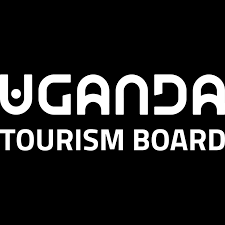Golden Monkey Trekking In East Africa
Golden Monkey Trekking
If you’re visiting Rwanda or Uganda for mountain gorilla trekking, we recommend you add golden monkey trekking to your itinerary. This rare experience lets you encounter one of Africa’s most colorful and elusive primates in the wild.
Golden monkeys live only in the Virunga Mountains, a striking chain of mostly dormant volcanoes spanning Uganda, Rwanda, and the Democratic Republic of Congo (DRC).
Once shy and hard to see, golden monkeys became more accessible after 2002, when the Dian Fossey Gorilla Fund launched a habituation program in Rwanda’s Volcanoes National Park. Today, trekking is also offered in two other national parks, giving visitors a chance to observe these playful, social monkeys in their misty mountain home.
What Makes the Golden Monkey So Special?
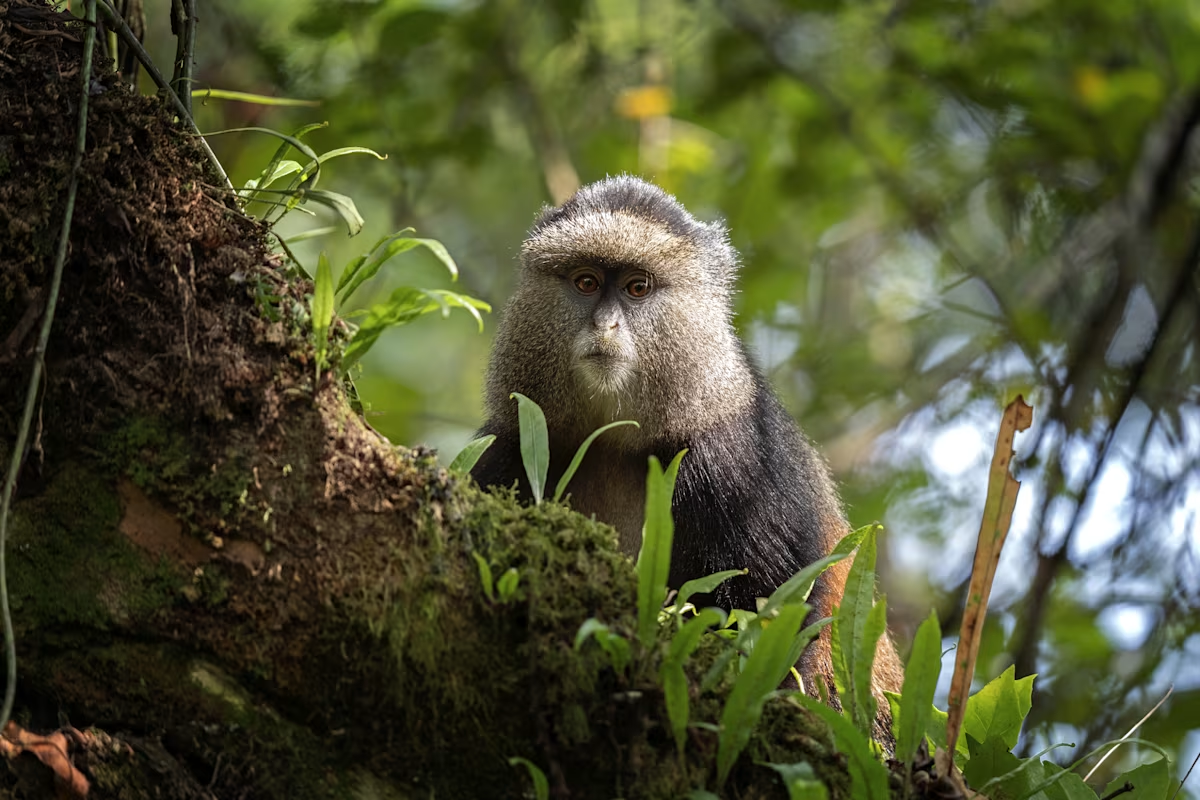
While mountain gorillas steal most of the spotlight in the Virungas, the golden monkey (Cercopithecus kandti) is equally captivating. True to its name, this small, bamboo-loving primate is stunningly beautiful. It resembles the more familiar blue monkey (C. mitis), and some experts even consider it a subspecies, but unlike the plain blue-gray coat of the blue monkey, the golden monkey has a striking fiery gold-orange patch along its back.
The golden monkey is listed as Endangered on the IUCN Red List. Once widespread across the highland forests of the Albertine Rift Valley, it is now found only in the Virunga Mountains and the isolated Gishwati-Mukura National Park.
Despite its limited range, which it shares with mountain gorillas, it is the most common primate in the area. A 2003 survey suggested there were 3,000 to 4,000 golden monkeys in Uganda alone, though more recent studies hint that the actual number is likely lower.
Best Places for Golden Monkey Trekking
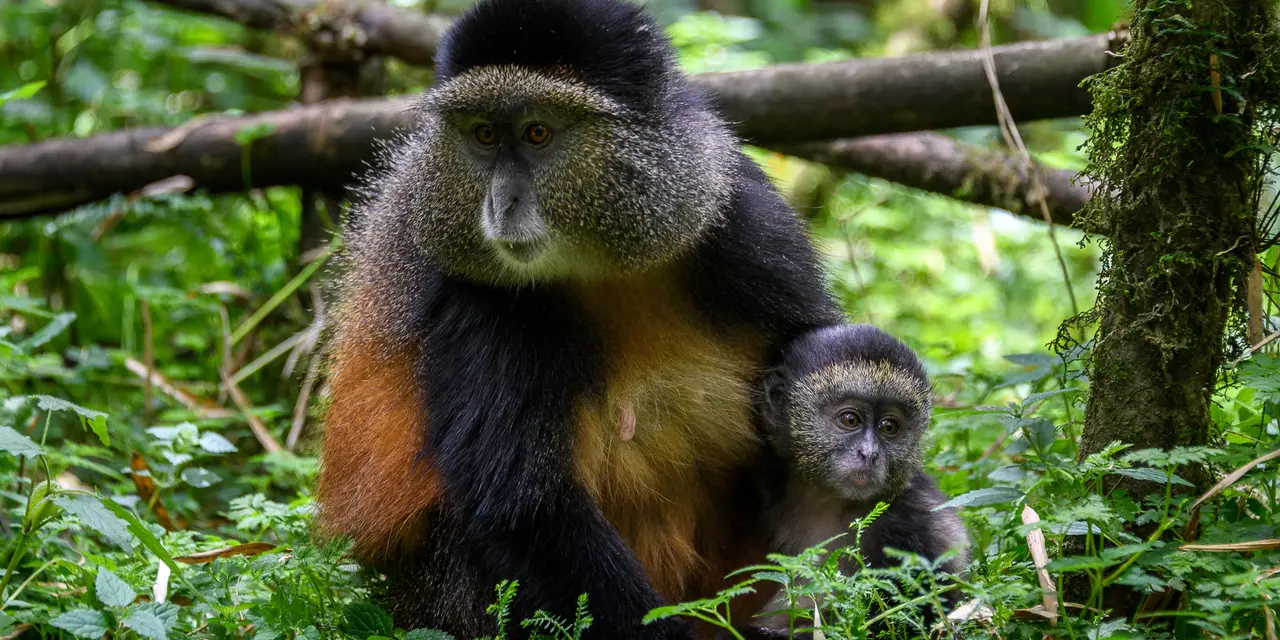
1. Volcanoes National Park
Founded in 1925 to protect the Rwandan slopes of the Virunga Mountains, Volcanoes National Park is world-famous as the ultimate destination for gorilla trekking.
But beyond the gorillas, it has also become one of the best places for golden monkey trekking, offering visitors a unique chance to see these beautiful primates up close.
The park is home to two habituated groups, with the Sabyinyo Group being the largest and most visited, consisting of 80 to 100 monkeys.
Volcanoes National Park is ideal for anyone looking for a reliable and accessible golden monkey experience. Since these monkeys were the first to be habituated, they are now very comfortable around humans, relaxed in their movements, and easy to observe and photograph.
The monkeys are often seen venturing into nearby farms to feed on potatoes and other crops, which makes it even easier for guides to locate them without trekking far into the forest. This creates an amazing opportunity to watch them closely and capture great photos, though the experience is slightly different from encountering golden monkeys deep in the untouched forest, where the sense of wilderness and mystery is stronger.
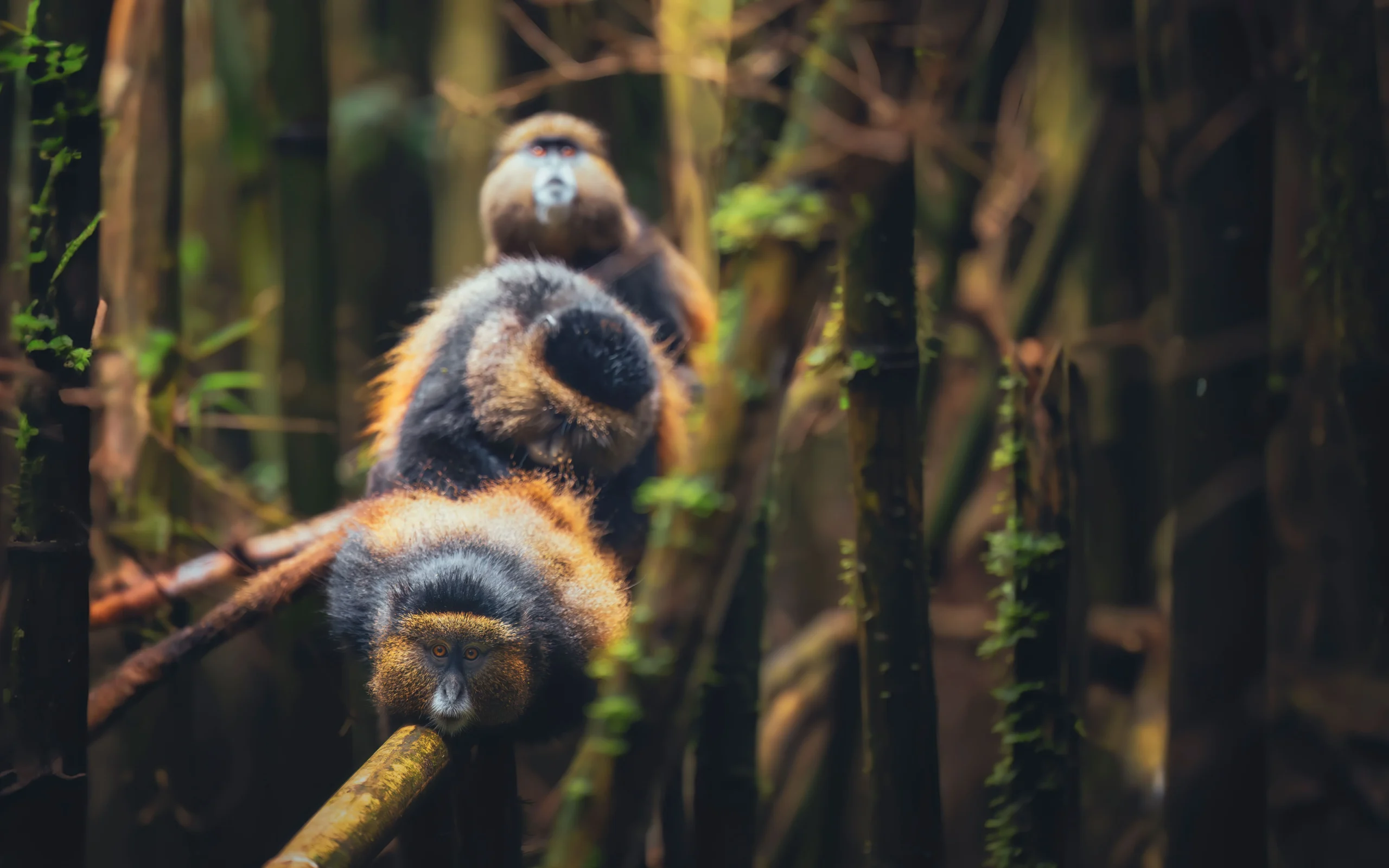
2. Mgahinga Gorilla National Park
Uganda’s Mgahinga Gorilla National Park is more famous for its golden monkeys than its gorillas. Unlike Bwindi Impenetrable Forest, which is home to more than 25 habituated gorilla groups, Mgahinga has only one. But what makes it truly special is that it is the only place in Uganda where golden monkeys live, making it a unique destination for wildlife lovers.
The trek to see them is a little more challenging than in Volcanoes National Park, as you must hike for 60 to 90 minutes uphill through thick, green secondary forest to reach the monkeys’ territory. The climb can be tiring, but the reward is incredible—you get to watch the golden monkeys jump, play, argue, and munch on fresh bamboo shoots in their natural forest home.
Mgahinga offers two different golden monkey experiences. The standard visit, similar to what you find in Rwanda, gives you one hour with the monkeys, which is plenty of time to enjoy their playful antics and observe their social behavior. But the park also offers something truly special, unique to Mgahinga—the in-depth habituation experience.
If you choose this, you spend four hours with the monkeys and the researchers who study them. This is a rare chance to see golden monkeys in much greater detail, learn about their behavior, and get a fascinating behind-the-scenes look at how scientists work to understand and protect these enchanting creatures. For anyone who loves primates, it’s an unforgettable and educational adventure.
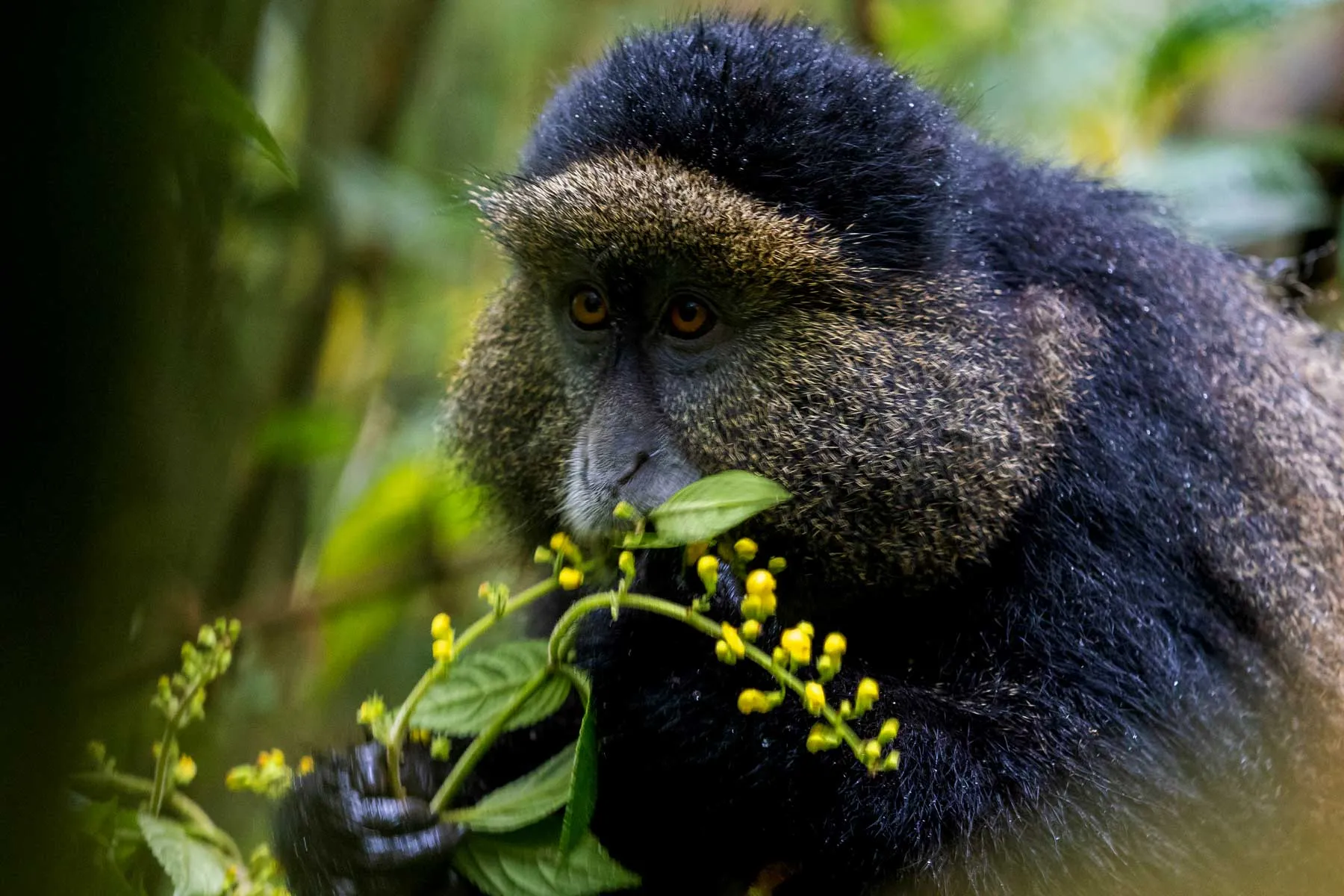
3. Gishwati-Mukura National Park
Rwanda’s newest national park, Gishwati-Mukura, was officially established in 2015 to protect two small, isolated forest patches covering a total of 35 km² (14 mi²).
What makes this park truly unique in East Africa is that it was created through a local community initiative, aimed at preserving the remaining forest and expanding it with reforested buffer zones.
Gishwati-Mukura is also remarkable for its wildlife. It is the only golden monkey stronghold outside the Virunga Mountains, home to a small, isolated population of about 170 individuals.
The park opened to tourism in 2020, but guided forest walks are currently available only to overnight guests at the community-run Forest of Hope Guest House and campsite.
While formal golden monkey trekking is not yet established here, a troop is in the process of being habituated. Visitors on forest walks often encounter golden monkeys, along with chimpanzees, L’Hoest’s monkeys, and a variety of rare forest birds.
For wildlife enthusiasts, Gishwati-Mukura offers a rare and intimate glimpse into a recovering forest ecosystem, where conservation efforts and local community involvement come together to protect some of Rwanda’s most precious species.
Why you should do a golden monkey trek before your gorilla trek?
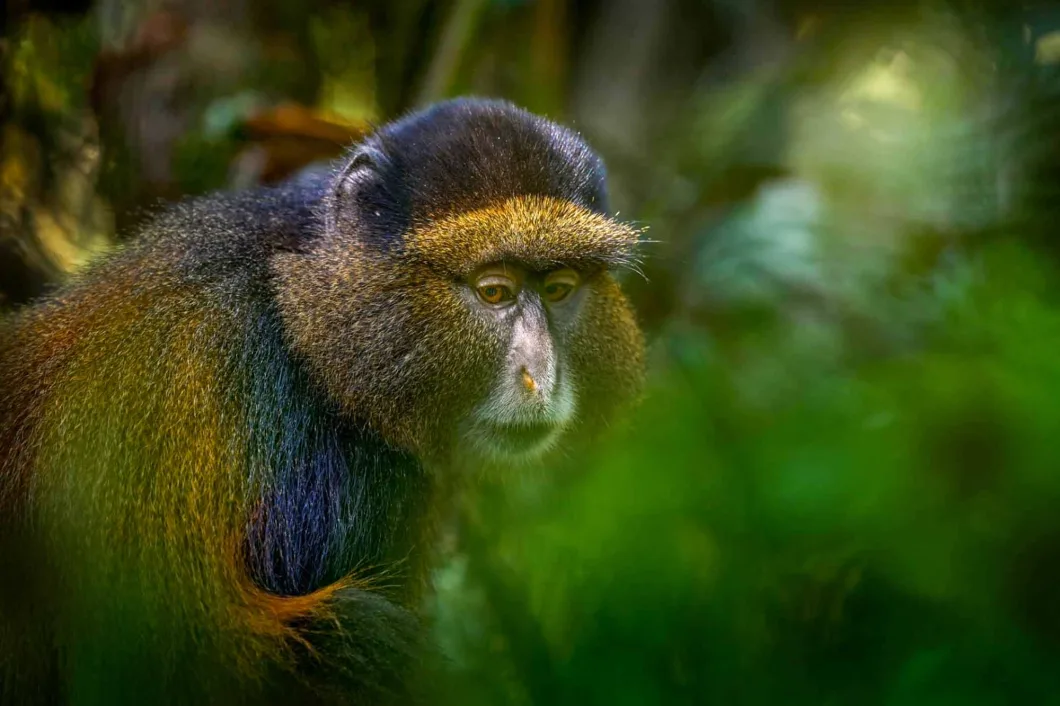
A golden monkey trek helps you to acclimatize
Golden monkey trekking is a gentle way to ease into the high altitudes of the Virunga Mountains.
The lowest elevations in Mgahinga Gorilla National Park and Volcanoes National Park start around 2,200–2,400 m, while mountain gorilla treks often take you higher, sometimes approaching 3,000 m—where altitude sickness can start affecting travelers, especially those arriving from near sea level.
Golden monkeys generally inhabit the lower slopes, and the habituated troops you can visit are usually found in these less steep areas. By contrast, mountain gorilla groups are often higher up, making their treks longer and more strenuous. Doing a golden monkey trek first allows your body to adjust gradually to the altitude without overexertion, making your gorilla adventure safer and more enjoyable.
Think of it as the perfect “warm-up” in a breathtaking forest.
Double the Adventure
One trek in the Virungas is never enough!
Golden monkey trekking takes you through a different slice of this magical landscape, from verdant farmland at the mountain base to misty forests where wildlife thrives.
Along the way, you may cross a buffalo wall, a historic barrier protecting crops, while enjoying views that mix cultural and natural wonders. And it’s not just monkeys or gorillas you’ll encounter.
The Virungas are rich in birds and wildlife—Uganda alone boasts over 1,000 bird species, far outnumbering larger countries like Russia. Every trek brings new sights, sounds, and experiences, making the forest feel alive in entirely different ways.
Affordable, Rare, and Rewarding
Golden monkey trekking also comes with a pleasant surprise: it’s easy on the wallet. Permits cost just US$60 in Uganda and US$100 in Rwanda.
Compare that with a mountain gorilla permit—$800 in Uganda and $1,500 in Rwanda—and adding a golden monkey trek becomes an irresistible bonus for just a small extra investment.
In short, a golden monkey trek is easier, scenic, wildlife-rich, and budget-friendly—the ideal complement to your gorilla adventure. It primes your body, enriches your experience, and lets you spend more time in one of Africa’s most stunning landscapes
More Things To Know About Golden Monkey Trekking
Standard visits are limited to one hour, giving you just enough time to observe their playful behavior, social interactions, and bamboo-feeding routines. There is no minimum age for visitors, so families can enjoy this experience together. However, parents should note that the walks can be quite challenging for young children, as the terrain is often steep or uneven.
The cost of golden monkey trekking varies by park. At Volcanoes National Park, a standard trek is US$100, while at Mgahinga Gorilla National Park it is US$60. The unique habituation experience at Mgahinga costs US$100, giving you four hours with the monkeys and researchers.
At Gishwati-Mukura National Park, guided forest walks are included in the accommodation or camping fee, offering a more intimate glimpse into the forest and its wildlife.
Our Trusted Partners
